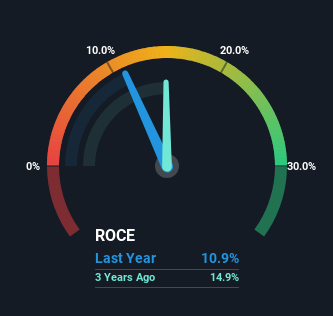- China
- /
- Electronic Equipment and Components
- /
- SZSE:002960
Jade Bird Fire (SZSE:002960) Might Be Having Difficulty Using Its Capital Effectively
If you're not sure where to start when looking for the next multi-bagger, there are a few key trends you should keep an eye out for. Firstly, we'll want to see a proven return on capital employed (ROCE) that is increasing, and secondly, an expanding base of capital employed. Basically this means that a company has profitable initiatives that it can continue to reinvest in, which is a trait of a compounding machine. In light of that, when we looked at Jade Bird Fire (SZSE:002960) and its ROCE trend, we weren't exactly thrilled.
Return On Capital Employed (ROCE): What Is It?
Just to clarify if you're unsure, ROCE is a metric for evaluating how much pre-tax income (in percentage terms) a company earns on the capital invested in its business. To calculate this metric for Jade Bird Fire, this is the formula:
Return on Capital Employed = Earnings Before Interest and Tax (EBIT) ÷ (Total Assets - Current Liabilities)
0.11 = CN¥726m ÷ (CN¥8.2b - CN¥1.6b) (Based on the trailing twelve months to September 2023).
So, Jade Bird Fire has an ROCE of 11%. On its own, that's a standard return, however it's much better than the 5.4% generated by the Electronic industry.
See our latest analysis for Jade Bird Fire

In the above chart we have measured Jade Bird Fire's prior ROCE against its prior performance, but the future is arguably more important. If you'd like, you can check out the forecasts from the analysts covering Jade Bird Fire for free.
What Does the ROCE Trend For Jade Bird Fire Tell Us?
Unfortunately, the trend isn't great with ROCE falling from 29% five years ago, while capital employed has grown 375%. That being said, Jade Bird Fire raised some capital prior to their latest results being released, so that could partly explain the increase in capital employed. Jade Bird Fire probably hasn't received a full year of earnings yet from the new funds it raised, so these figures should be taken with a grain of salt. Also, we found that by looking at the company's latest EBIT, the figure is within 10% of the previous year's EBIT so you can basically assign the ROCE drop primarily to that capital raise.
On a related note, Jade Bird Fire has decreased its current liabilities to 19% of total assets. So we could link some of this to the decrease in ROCE. What's more, this can reduce some aspects of risk to the business because now the company's suppliers or short-term creditors are funding less of its operations. Since the business is basically funding more of its operations with it's own money, you could argue this has made the business less efficient at generating ROCE.
The Bottom Line On Jade Bird Fire's ROCE
Bringing it all together, while we're somewhat encouraged by Jade Bird Fire's reinvestment in its own business, we're aware that returns are shrinking. Additionally, the stock's total return to shareholders over the last five years has been flat, which isn't too surprising. Therefore based on the analysis done in this article, we don't think Jade Bird Fire has the makings of a multi-bagger.
On a separate note, we've found 1 warning sign for Jade Bird Fire you'll probably want to know about.
For those who like to invest in solid companies, check out this free list of companies with solid balance sheets and high returns on equity.
New: Manage All Your Stock Portfolios in One Place
We've created the ultimate portfolio companion for stock investors, and it's free.
• Connect an unlimited number of Portfolios and see your total in one currency
• Be alerted to new Warning Signs or Risks via email or mobile
• Track the Fair Value of your stocks
Have feedback on this article? Concerned about the content? Get in touch with us directly. Alternatively, email editorial-team (at) simplywallst.com.
This article by Simply Wall St is general in nature. We provide commentary based on historical data and analyst forecasts only using an unbiased methodology and our articles are not intended to be financial advice. It does not constitute a recommendation to buy or sell any stock, and does not take account of your objectives, or your financial situation. We aim to bring you long-term focused analysis driven by fundamental data. Note that our analysis may not factor in the latest price-sensitive company announcements or qualitative material. Simply Wall St has no position in any stocks mentioned.
About SZSE:002960
Jade Bird Fire
Researches, develops, manufactures, and sells professional fire safety electronic products and intelligent fire safety systems in China and internationally.
Excellent balance sheet and fair value.
Market Insights
Community Narratives



